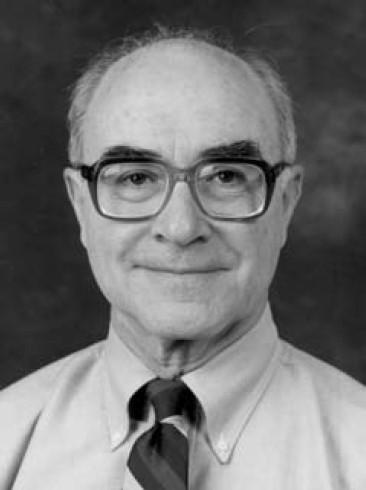
1932–2009
Elected in 1993
“For contributions to the application of computers to data acquisition, analysis, and control for scientific experiments.”
BY JOEL S. BIRNBAUM
ROBERT J. SPINRAD, a computer pioneer and one of the fathers of modern laboratory automation, died on September 2, 2009, of Lou Gehrig’s disease (ALS) at his home in Palo Alto, California. He was 77 years old.
Born in Manhattan, New York, on March 20, 1932, Spinrad attended the Bronx High School of Science, where, in addition to whetting his already burgeoning interest in science and engineering, he met fellow student Verna Winderman; the high school sweethearts were wed in June 1954 and were married for 55 years. He is survived by Verna, two children, and three grandchildren.
Bob attended the Columbia University School of Engineering, receiving a B.S. in electrical engineering in 1953. He was a regents scholar and the student council president, and in his senior year he built his own computer from discarded telephone switching equipment. Computer science was not yet part of the curriculum, and most people had no interest in his machine. “I may as well have been talking about the study of Kwakiutl Indians, for all my friends knew,” he told an interviewer for the New York Times in 1983. Bob was named a Samuel Willard Bridgham Fellow and earned an M.S. in electrical engineering from Columbia in 1954.
In 1955, Bob joined the staff of the Brookhaven National Laboratory, where he worked until 1968, with four years’ leave to attend the Massachusetts Institute of Technology (MIT), where as a Whitney Fellow he received a Ph.D. in electrical engineering in 1963. He also spent a summer at Los Alamos National Laboratories, learning about scientific computer design; back at Brookhaven he designed a room-sized computer he named Merlin, using vacuum tubes, as the use of transistors was not yet prevalent. From 1965 on, Bob was head of the Computer Systems Group and supervised the design of elegant, innovative systems that helped make the control of experiments and the collection, display, and analysis of data both more efficient and effective. While he had novel ideas about the potential interplay between instruments and computers, he realized that the critical link in the experimental feedback loop was the scientist. He blazed new trails in user interfaces and data visualization and was one of the first people to realize that the course of an experiment could be dramatically affected by properly presented real-time measurements. His widely emulated work resulted in a number of classic papers and talks and in his being invited to write an influential cover article on laboratory automation for Science in 1967.
In 1968, Bob left Brookhaven to join the newly formed Scientific Data Systems, where he became vice president of programming. SDS made innovative scientific machines that became popular in laboratories and universities. It was acquired by Xerox in 1969, where it became known as XDS. Bob and his family moved to Southern California, where he led the work in office automation, prototyping communicating word processors, laser printers, and local area networks. The SDS 930 was used by Project Genie at Berkeley in some of the earliest time-sharing experiments; that group formed the Berkeley Computer Corporation, which in turn became the nucleus of the Xerox Palo Alto Research Center (PARC), where much of the technology that led directly to modern personal computers and the local area networks that connect them was invented in the early and mid-1970s.
Bob was named vice president of research and headed PARC from 1978 to 1983, during the period when the laboratory’s technology was commercialized, including the first modern personal computer, the Ethernet, and the laser printer. Some of the researchers, frustrated by Xerox’s uncertainty about competing in the general computer business, left to form or join new companies based on the PARC technology; these included Apple, Adobe, and 3Comm, to name just a few.
During this period, and for the remainder of his Xerox career, Bob was an eloquent spokesman for a vision of computing that incorporated networks of personal and shared devices backed by a global information infrastructure that is similar to the situation today. He became the leader of Xerox Technology Analysis and Development and remained an influential thought leader in the company’s evolution until his retirement.
Throughout his long and productive career, Bob Spinrad was a sought-after speaker and a trusted advisor to a diverse set of government organizations and universities. These included Harvard, Stanford, MIT, the University of California at Berkeley, the Jet Propulsion Laboratory, Educom (the trade name for the Interuniversity Communications Council, Inc., an organization dedicated to the idea that digital computers offered an incredible opportunity for sharing among institutions of higher education), the National Science Foundation, the National Research Council, the Council on Foreign Relations, the U.S. Department of Defense’s Advanced Research Projects Agency, and the California Council on Science and Technology, to name some of the many that benefited from his insights and dedication. Bob was a superb industry citizen, serving on many conference program committees, editorial boards, and visiting committees. In recognition of his achievements, he was elected to both the National Academy of Engineering and the American Academy of Arts and Sciences.
His quiet, gentle manner helped him lead by example, and the passion he felt for technology and its application was infectious. These qualities, coupled with an innate patience
and compassion, proved important in the development of many colleagues who became industrial and educational leaders in their own rights. Bob had as much pride in their accomplishments as in his own, but his greatest delight was to witness the inexorable march of technology in the directions that he had so accurately predicted and which he had done so much to help make real. He was, until the end, modest and positive and enjoyed the respect and affection of all who knew him. He was one of those rare individuals who made our world a far better place than he found it.






